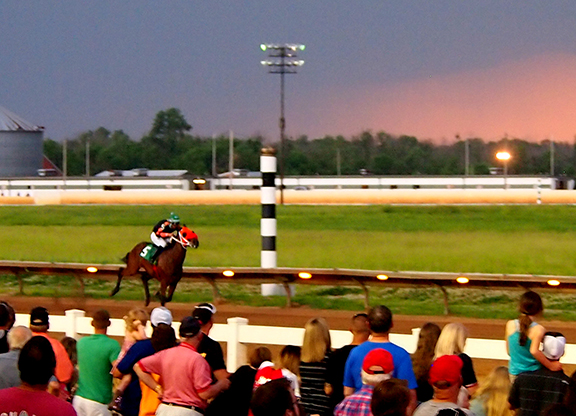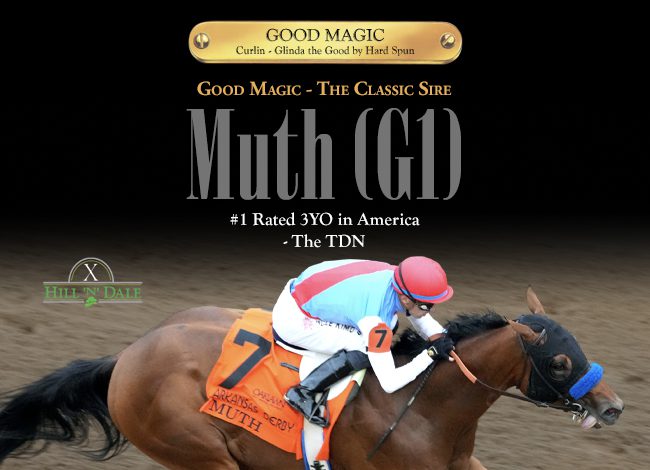By T. D. Thornton
My wife is on a quest to visit all 50 states in America, and now that we're down to the last 10, we have a deal: She gets to pick the destination, but I choose the itinerary. A couple months back, when she suggested Missouri for a long weekend in June, it didn't take long for me to craft a plan–some hiking in the Ozarks, a stay in St. Louis to catch a Cardinals ballgame, and the highlight (for me at least), a Saturday night jaunt into nearby Illinois for racing under the lights at Fairmount Park.
After we booked the trip, our hometown hockey team, the Boston Bruins, got matched up against the St. Louis Blues for the Stanley Cup Final. Mrs. Thornton suggested we look into getting Game 3 tickets for Saturday–wouldn't that be awesome? Putting aside the fact that $900 nosebleed seats are well beyond a Thoroughbred journalist's budget, I reminded her that no self-respecting racetrack degenerate would pass up the opportunity to visit a different track for the first time–especially the ones that are slowly sliding off the grid.
Fairmount, which dates to 1925, has been on the endangered species list for years thanks to competing riverboat casinos in Missouri and the too-familiar laundry list of reasons why Thoroughbred venues everywhere are struggling right now. They race just two days a week for the Apr. 16-Sep. 14 season, and it is hard to imagine the southern Illinois heyday of the 1950s and 60s when Fairmount and nearby Cahokia Downs anchored a competitive regional racing circuit.
Everywhere you went in St. Louis on the first weekend in June, it was being touted as the biggest sports weekend in the city's history because of Cards/Cubs and Blues/Bruins. You'd chat in the hotel elevator with a stranger, and they'd ask which game you were going to on Saturday night. We got a lot of blank stares when we said we'd be at the rail at Fairmount Park.
I surmised we'd have plenty of room trackside. Given all the hoopla going on in St. Loo, my prediction was that this would be the least-attended day of racing I ever dragged my wife to, and she has endured more than her share of trips to leaky-roof tracks.
We pointed the rental car east across the Mississippi, which was cresting toward record flooding after weeks of relentless rain upstream. An entire riverfront boulevard behind the famed Gateway Arch was drowned under brown, swirling water, and you wouldn't even know it was there except for the head of a very large statue poking up above the ooze. The phrase “Hell or high water” came to mind as I prepared to pay respects to Fairmount.
Collinsville, Illinois, is only a dozen miles away but a world removed from downtown St. Louis. We got off the interstate an exit before the track with the hope that a little karma would rub off on us at the Cahokia Mounds historic site, which in the 13th century was a thriving Native American urban center that was once “one of the greatest cities of the world.” Today, the remaining 1.5 miles to Fairmount stand as a testament to what civilization has done in 800 years since: Stop & Go Liquor, Herman's Pawn Shop, Pawn King, and Outlaw Scrap Metal provide a bleak gauntlet on the road to pari-mutuel glory. The track itself is flanked by the tractor-trailer hum of I-55 and a wastewater treatment plant. A water tower in the shape of a gigantic catsup bottle, billed as the world's tallest, juts like a lonely sentinel of roadside Americana 170 feet above this well-worn city of 25,000.
We turned into the Fairmount main gate and encountered a sight I had not prepared myself to see: A small army of parking flaggers fervently waving a robust line of cars into the free lot that was nearly halfway full some 90 minutes before first post. What were all these people doing here? My prediction about Fairmount being desolate turned out to be the first of my usual series of bad guesses at the races.
We were conspicuous out-of-towners because of our lack of Blues and Cards garb. The $13 “Party at the Park” promotion was the main draw, with a live band belting out 80s rock, the buffet line doubling back on itself, and pints of good local craft beer going for a ridiculously cheap $3 a pop. Each of the evening's seven races had a sponsor, and my attempt to peek into the clubhouse dining area was met with a friendly rebuff that it was booked solid for ticketed group sales events. This is a track that is supposed to be on its last legs?
The problem, of course, is that hardly anybody in this throng bets. One rolling double pool was $567 and the on-track handle for the night ended up being $65,948. The crowd was five deep at the rail, with lots of kids running around and young'uns hoisted atop shoulders to see the ponies in the neatly landscaped paddock. These fans cheered everything–horses going into the gate, horses hurtling down the stretch, and even the brilliant lightning show that stopped the card partway through and forced everyone into the bunker of a grandstand that has barely changed since 1974 when a fire consumed the first one, save for banks of simulcast TVs and self-service bet machines.
The racing? It was about what you'd expect, and I don't say that disparagingly because I firmly believe the sport needs lower-level venues like Fairmount to survive.
The June 1 program was the first of the year to have a race with more than seven starters. An 0-for-22 maiden won the opener for a 1-for-71 trainer. The third race included three tough 10-year-old geldings. The fifth had an 11-year-old maiden. Victor Santiago, the meet's second winningest jockey, had ridden at Arlington that afternoon, bombed down to Fairmount at night, then went back to Arlington for mounts on Sunday, a round trip of some 700 miles. Fairmount's announcer, Keith Nelson, commutes from near Kansas City twice a week, a 540-mile out-and-back. For everyone involved, that's a tough way to make a living.
When I got home two days later, news broke that the Illinois General Assembly had passed a massive gambling expansion and the governor was poised to sign a bill to allow racetracks to add slot machines, table games and sports betting. Brian Zander, Fairmount's president, told the St. Louis Post-Dispatch that $7,000 per-race purses would roughly double. Fairmount currently cards 287 races annually. It is unclear where they will get the horses to satisfy the new minimum requirement of 700 races per season.
Nearly three decades into the racino era, Thoroughbred venues all across the land are having trouble giving away the embarrassment of riches from gaming windfalls because of the nationwide horse shortage. So it's not as if Fairmount's quality of racing should be expected to improve dramatically.
But I get a sense that the little guys in Collinsville scored an overlooked victory in sports-crazed metro St. Louis, so the enthusiastic race fans there are entitled to party like it's 1999 if they want to.
Not a subscriber? Click here to sign up for the daily PDF or alerts.






